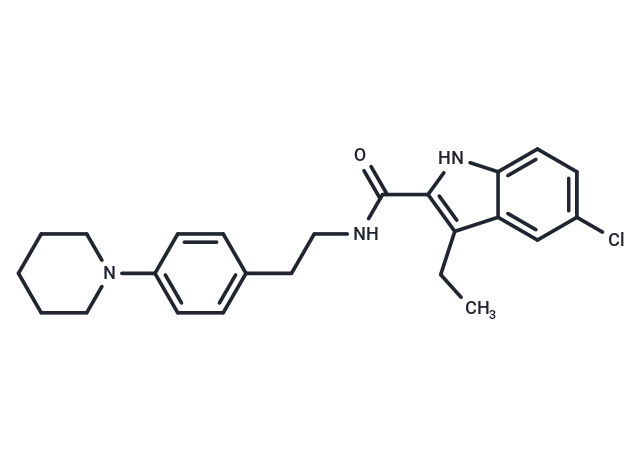Shopping Cart
- Remove All
 Your shopping cart is currently empty
Your shopping cart is currently empty

Org 27569, an allosteric modulator of cannabinoid CB1 receptor, can induce a CB1 receptor state that is characterized by decreased inverse agonist affinity and enhanced agonist affinity.

| Pack Size | Price | Availability | Quantity |
|---|---|---|---|
| 2 mg | $31 | In Stock | |
| 5 mg | $48 | In Stock | |
| 10 mg | $81 | In Stock | |
| 25 mg | $159 | In Stock | |
| 50 mg | $297 | In Stock | |
| 100 mg | $443 | In Stock | |
| 1 mL x 10 mM (in DMSO) | $48 | In Stock |
| Description | Org 27569, an allosteric modulator of cannabinoid CB1 receptor, can induce a CB1 receptor state that is characterized by decreased inverse agonist affinity and enhanced agonist affinity. |
| In vivo | ORG 27569 (3.2 and 5.6 mg/kg, intraperitoneally) significantly reduces both cue-induced and priming-induced reinstatement of cocaine and methamphetamine in rats[4]. At a dosage of 30 mg/kg, intraperitoneally, ORG 27569 suppresses appetite independent of CB1 receptors and does not alter the discriminative stimulus effects of anandamide (AEA). Additionally, intracerebroventricular administration of ORG 27569 (100 μg) does not influence the pharmacological effects of systemic CP55,940 compared to a vehicle[5]. |
| Kinase Assay | Equilibrium Binding Assays.: Binding assays are performed with the CB1 receptor agonist [3H]CP 55,940 (0.7 nM) and the CB1 receptor antagonist [3H]SR 141716A (1.2 nM), 1 mg/ml BSA and 50 mM Tris buffer containing 0.1 mM EDTA and 0.5 mM MgCl2, pH 7.4, in a total assay volume of 500 μl. Binding is initiated by the addition of mouse brain membranes (30 μg). Assays are carried out at 37°C for 60 min before termination by addition of ice-cold wash buffer (50 mM Tris buffer and 1 mg/ml BSA) and vacuum filtration using a 24-well sampling manifold and Whatman GF/B glass-fiber filters that have been soaked in wash buffer at 4°C for 24 h. Each reaction tube is washed five times with a 4-ml aliquot of buffer. The filters are oven-dried for 60 min and then placed in 5 ml of scintillation fluid, and radioactivity is quantitated by liquid scintillation spectrometry. Specific binding is defined as the difference between the binding that occurred in the presence and absence of 1 μM concentrations of the corresponding unlabeled ligand and is 70 to 80% of the total binding. |
| Cell Research | Cells expressing CB1 receptors are exposed to ORG27569 (10 μM) for 5 to 15 min. For toxin treatment to abrogate Gi coupling effects, PTX is added to the medium at 5 ng/ml. Following an 18-h incubation in the presence of toxin, cells are washed twice with PBS and treated with compounds. Cells are washed with ice-cold PBS, and cell lysates are obtained by harvesting the cells with ice-cold lysis buffer (150 mM NaCl, 1.0% IGEPAL CA-630, 0.5% sodium deoxycholate, 0.1% SDS, and 50 mM Tris, pH 7.5 containing 4-(2-aminoethyl)benzenesulfonyl fluoride, pepstatin A, E-64, bestatin, leupeptin, and aprotinin as protease inhibitors).(Only for Reference) |
| Molecular Weight | 409.95 |
| Formula | C24H28ClN3O |
| Cas No. | 868273-06-7 |
| Smiles | CCc1c([nH]c2ccc(Cl)cc12)C(=O)NCCc1ccc(cc1)N1CCCCC1 |
| Relative Density. | 1.218g/cm3 |
| Storage | Powder: -20°C for 3 years | In solvent: -80°C for 1 year | Shipping with blue ice. | |||||||||||||||||||||||||||||||||||
| Solubility Information | DMSO: 41 mg/mL (100.01 mM), Sonication is recommended. | |||||||||||||||||||||||||||||||||||
Solution Preparation Table | ||||||||||||||||||||||||||||||||||||
DMSO
| ||||||||||||||||||||||||||||||||||||

Copyright © 2015-2025 TargetMol Chemicals Inc. All Rights Reserved.